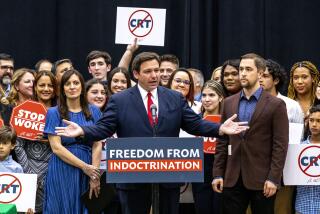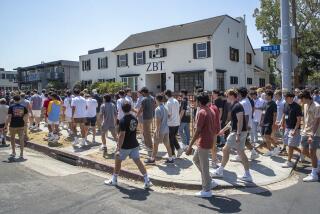Campus Life: UNDERGRADUATE CULTURES FROM THE END OF THE EIGHTEENTH CENTURY TO THE PRESENT by Helen Lefkowitz Horowitz (Knopf: $24.95; 330 pp., illustrated)
- Share via
The words college life bring to mind many different images and memories for those who have been there, or for parents who have worked hard to send their children there. Henry Adams wrote of Harvard College “. . . Harvard teaches one little, and that little ill . . . .” But until now, no one historian has put into perspective the ways in which students throughout American history have lived their college lives as adeptly as Helen Lefkowitz Horowitz has delineated them in “Campus Life.”
It is difficult at best to rest easy with generalizations about the kinds of students who have attended both private and public colleges and universities in the United States. Horowitz does this by asserting that students can be categorized as “outsiders,” “college men,” “rebels,” “women,” or “new outsiders.” She writes that these categories grew out of revolt: “Records of youthful hedonism and collegiate customs in North America go back to Harvard’s beginnings. Its poverty, simplicity, piety, and small scale may have initially inhibited adolescent enthusiasm, but Harvard, in the heart of Puritan New England, caught its students playing cards, drinking, and stealing the turkeys of their Cambridge neighbors.” From there, collegiate rebellions split men and women into rebels, nerds and the like.
While bordering on the general, Horowitz’s extensive research and historical analysis bring interesting facts and anecdotes about so many varied people that the otherwise precariously broad categories seem to make sense. The author admits her own ambiguity about writing a comprehensive work on such a large topic, but her belief that the past kinds of collegiate life styles have profoundly shaped those of today carries weight. Indeed, Horowitz provides a most entertaining view of the evolution of student groups.
For instance, she traces the nature of political rebellion on campuses from the ‘50s to the ‘60s: “College rebels in the 1950s felt themselves to be beleaguered, a small minority on a campus indifferent or hostile to the issues they were raising. The Movement provided their 1960s counterparts with a sense of momentum, increasingly radical explanations for their discontent, and linked plans of action. Unlike both rebels and radicals in the 1930s, members of the New Left did not intend to educate fellow students with words and pledges. They engaged in direct action to build a moral society.” Such historical analysis serves to illuminate well the distinctions between decades and groups, as well as the effect one had on the other.
Upon entering a college today, one quickly ascertains that identification with a particular group is as important as knowing how best to attack a syllabus. Horowitz is quick to point out that no one student belongs entirely to one group: Students since the founding of Harvard College 350 years ago have transcended singular group identities. They are Cabots and Lodges, but they are artists and writers; they are women, but they are socially conscious; they are rebels, but they are nevertheless attracted to fraternities. This is an important qualification, and one which carries an otherwise generalization-oriented work.
Horowitz writes of her approach: “My hope is that this book may clarify the varieties of undergraduate life. To alumni, it may illumine a meaningful part of their past and connect it to the bewildering present. To entering students and their parents, it can serve as a road map, pointing out choices.”
She goes on to describe her overriding wish that students today not feel obliged to act within the norms that governed college life during their grandparents’ school years. By pointing out the fascinating multiplicity of any one student’s collegiate experiences at all kinds of colleges across the country during all different time periods, Horowitz accomplishes what she set out to do.
It might be difficult for an aspiring college student to read the work and imagine what place he or she might take in the “history” of the collegiate experience. But aspiring college students should read it, because the historiographic worth of Lefkowitz’s work is real, and indeed important. No one should be told to act a certain way in school, but students act along the lines delineated by Horowitz anyway. College students would probably like not to be categorized, but that is her point, and it is a good one.
More to Read
The biggest entertainment stories
Get our big stories about Hollywood, film, television, music, arts, culture and more right in your inbox as soon as they publish.
You may occasionally receive promotional content from the Los Angeles Times.










